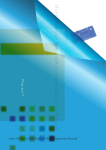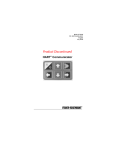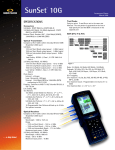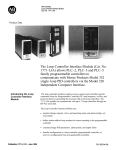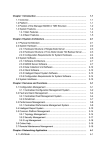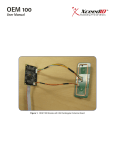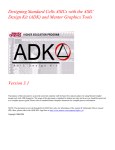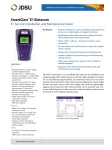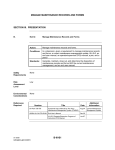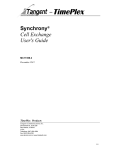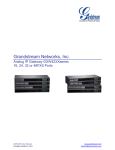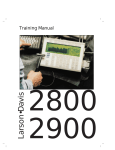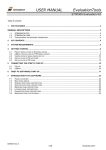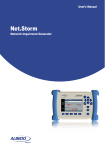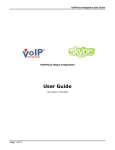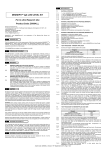Download VictoriaSTM-16/OC-48 Plus
Transcript
Datasheet VictoriaSTM-16/OC-48 Plus The Smartest Solution for Testing SDH/SONET/ATM/PDH/T-Carrier The Victoria STM-16/OC-48 Plus has all the features of a portable tester. Thanks to its small size and light weight, this battery-fed tester is the ideal solution for field work. The unique measurement features of Victoria make it suitable for a number of applications, both in and out of service: • • • • above ATM Adaptation Layers 2 and 5 (AAL-2 and AAL-5). The Iu and the Iub interfaces use the AAL-2 and AAL-5 to carry both user traffic and control traffic. By generating and emulating AAL2 and AAL5 traffic, commissioning of connections as well as in-service measurements are performed on 3G mobile networks. Installation Remote Control Acceptance and commissioning A Victoria STM-16/OC-48 Plus tester can be controlled from anywhere in the world, thanks to the remote control system that makes use of the Internet. Monitoring and surveillance Repair and maintenance This enables you to test the whole network, manage and compare results and give help to your field technicians from one single control centre. Product Highlights The following can be highlighted from among the basic remote control features of Victoria: 3G/UMTS Network Telecom networks have evolved towards the integration of SDH/ SONET, ATM and IP technologies under one single architecture, thus making it easier to bring today’s new telematics applications into service. • • • Graphical interface based on intuitive, easy-to-use windows Simultaneous control of many instruments Client/Server architecture fully integrated into the Internet The UMTS (3G) is a very typical example of a network where several technologies are merged, and these need to be separetely tested. After testing the physical layer, the ATM layer and the ATM Adaptation Layer (AAL) must also be tested. ADM ADM OC-48 Victoria MSC Circuit Switched Network E1 Node B RNC Victoria RClient STM-1 Victoria TCP/IP POTS STM-1 Victoria STM-1 SGSN E1 Node B RServer Packet Switched Network RNC ATM in E1, E3, STM-1... interfaces The 3GPP (3G Partnership Project) defines a rich set of protocols between the end user and other networks. These protocols sit TrendCommunications RClient Datasheet 2 Tests in International Gateways The current technological needs call for testers that meet the varying standards of different countries. It is an essential requirement that a tester can interact with both European and American interfaces. It is necessary to define the type of error and the part of the SDH/ SONET signal affected, to find out which link or network element is causing the problem. The scan function makes it possible to locate and isolate network events automatically. This function works at any hierarchical level, and it can be used for any type of mapping or tributary signal. The path trace analysis and TCM capabilities of Victoria are also very useful when identifying the affected link. SONET Evaluating Analog Parameters Victoria Before carrying out any digital measurements, it must be checked that the analog parameters of the signal remain within certain margins. Victoria Victoria makes it possible to instantly check that the optical power and the frequency of the received signal are within the margins accepted by the ITU. High capacity DXC SDH SONET Network Victoria has the capacity to work with both SDH and SONET or PDH and T-Carrier at the same time, and this makes it a necessary tool in testing high-capacity gateways that interconnect SDH and SONET backbones. Ideal incoming signal Besides this, the use of some ANSI interfaces is becoming more common in Europe. For example, the use of DS3 signals at 45 Mbit/s is increasing in such applications as MPEG video transport. Incoming signal power too low Alarm and Error Scan SDH/SONET signals are formed by multiplexed lower order tributaries. Some of these tributaries may get affected by errors or alarms, whereas others remain intact. Incoming signal frequency out of range Victoria C B Unavailable path: AIS E3 E3 With Victoria STM-16/OC-48 Plus, it is safe to establish connection to a link to carry out an optical power measurement, as the receiver is protected against any overload that might damage it. ADM A Frequency measurements are not limited only to presenting measurement results in Hertz, but it is also possible to make sophisticated synchronization measurements: E3 STM-1 DXC • TIE (Time Interval Error) measurement; TIE is caused by pointer movements in SDH and SONET • Programming and analysis of standard pointer sequences, to test network tolerance • Frequency offset generation in PDH / T-Carrier tributaries in SDH or SONET signals. Victoria STM-1 SCAN Path A: OK Path B: OK Path C: E3 AIS ADM E3 E3 E3 B A C Datasheet 3 • Tandem Connection Monitoring In a multi-operator environment, there are some companies that offer transmission services of other operators or companies. In these circumstances, it is essential to delimit responsibilities whenever a problem occurs. The Tandem Connection Monitoring (TCM) protocol has been designed for this purpose. Create new specialized measurements that the user can create, such as repetitive BERT used when installing radio links Technical Specifications TRANSMISSION Electrical Interfaces ERRORS Operator C Operator B SDH/SONET TCM events Operator A • • BNC (default), DIN 1.6/5.6 (option DIN55) • Optional: 1544 kbit/s B8ZS and AMI (option 30554), 44736 kbit/ s B3ZS & AMI (option 30552), pulses DS3-HI and DSX-3 (with accessory AD045), 51840 kbit/s B3ZS (option 30551) • Balanced Bantam (accessory AD300), Siemens (accessory AD320) and RJ48 (accessory AD322) for 1544 kbit/s and 2048 kbit/s • • Interfaces according to G.703, ANSI T1.102 and G.772 Rates: 2048 kbit/s HDB3 and AMI, 8448 kbit/s HDB3 and AMI, 34368 kbit/s HDB3, 139264 kbit/s CMI, 155520 kbit/s CMI Gain: 0, 20, 26, 30 dB from 1544 kbit/s to 51840 kbit/s; 0, 20, 26 dB for 139264 kbit/s and 0, 20 dB for 155520 kbit/s Optical Interfaces The TCM mechanism makes it possible to analyse the part of the path where a problem occurs when an SDH/SONET signal is crossing the network and arrives degraded at its destination. The Victoria STM-16/OC-48 Plus generates and analyses all type of TCM events to check that this protocol is working correctly. Automatic Measurements The ability to make automatic measurements by using macros makes Victoria STM-16/OC-48 Plus a powerful tool in carrying out repetitive tests, such as bringing-into-service and type approval of network equipment. • Built-in connectors for 155520 kbit/s, 622080 kbit/s and 2488320 kbit/s • • Interfaces according to the ITU-T G.957 L-16.1 and L-16.3 • • Automatic disconnection of the receiver for overload protection • Via external optical micromodules fed by the equipment for 34368 kbit/s (option 305531), 51840 kbit/s (option 305511), and 155520 kbit/s FC (default), SC (option 3090SC) or ST (option 3090ST) connectors 1310 nm transmitter (configurations 3095C1, 3095C4) and 1550 nm transmitter (configurations 3095C2, 3095C4) Clock Clock sources SES<S2 • • • • ISM PASS PHASE 3 Internal, according to G.812 Recovered from the incoming signal External 1544/2048 kHz with BNC connector External coded G.703 at 1544 kbit/s and 2048 kbit/s with BNC or balanced connector with 0 and 20 dB gain (accessory AD340) Modes ES<S1 ES<S2 PASS FAIL With the the macro utility you can: • • Carry out complex measurements with a single keypress • Program customized pass/fail tests that show the result by displaying a label on the screen Help field technicians throughout the measurement, by means of the graphical user interface of the tester • • • • SDH/SONET/PDH//T-Carrier termination SDH/SONET/PDH/T-Carrier, bridged SDH/SONET mux/demux Through mode for all the interfaces Datasheet 4 SDH • • • • • STS-48c C-4-4c in STM-4 and STM-16 • VT-1.5 bulk or with framed DS1 General • • Mappings According to G.707 and O.181 Programmable scrambler and background Mappings STS -12c STS-3c bulk or with framed E4 STS-1 bulk or with framed DS3 or E3 VT-2 bulk or with framed E1 (asynchronous or byte synchronous) • • • C-4-16c in STM-16 C-4 (unstructured or with framed E4) in STM-1, STM-4 and STM-16. Programmable Bytes • C-3 (unstructured or with framed E3 or DS3) in STM-0, STM-1, STM-4 and STM-16 (both with an AU-3 or AU-4) • C-12 (unstructured or with framed E1, asynchronous or byte synchronous) in STM-0, STM-1, STM-4 and STM-16 • C-11 (unstructured or with framed DS1) in STM-0, STM-1, STM4 or STM-16 • • • • Programmable Bytes Editing and display in hexadecimal or by descriptor • • • • • Display of all bytes and editing in hexadecimal or by descriptor of: SOH: A1, A2, J0, C1 LOH: K1, K2, S1 STS-POH: J1, C2, G1, H4, K3 VT-POH: J2, V5, K4 J0, J1, J2 Trail Trace • RSOH: A1, A2, J0, C1 Generation, analysis and expected 16- and 64-byte messages in J0, J1 and J2 MSOH: K1, K2, S1 Errors HO-POH (VC-4, VC-3): J1, C2, G1, H4, K3 • Insertion and detection of ECOD, EFAS, SEF, B1, B2, REI-L, STS-B3, REI-P, VT-B3, REI-V, BIP-2, slip and bit errors • Insertion mode: single, burst, repetitive burst and rate (1.1 x 10-3 to 0.9 x 10-9s) LO-POH (VC-3): J1, C2, G1, H4, K3 LO-POH (VC-12, VC-11): V5, J2, K4 Trail Trace Alarms • • Insertion and detection of LOS, LOF, TIM-S, AIS-L, RDI-L, AISP, LOP-P, UNEQ-P, RDI-P, TIM-P, PLM-P, LOM-V, AIS-V, LOPV, UNEQ-V, RDI-V, RFI-V, TIM-V, PLM-V, LSS pattern AIS • Insertion mode: continuous, burst of M frames with alarm, repetitive M/N burst Generation, analysis and expected 16- and 64-byte messages in J0, J1 and J2 Errors • Insertion and detection of ECOD, EFAS, OOF, B1, B2, MS-REI, HP-B3, HP-REI, LP-B3, LP-REI, BIP-2, slips and bit errors • Insertion mode: single, burst, repetitive burst and rate (1.1 x 10-3 to 0.9 x 10-9s) Alarms • • Insertion and detection of LOS, LOF, RS-TIM, MS-AIS, MS-RDI, AU-AIS, AU-LOP, HP-UNQ, HP-RDI, HP-TIM, HP-PLM, TULOM, TU-AIS, TU-LOP, LP-UNQ, LP-RDI, RFI, LP-TIM, LPPLM, LSS, pattern AIS. Insertion mode: continuous, burst of M frames with alarm, repetitive M/N burst Pointer Events • Increment, decrement, manual value with or without NDF, invalid pointer in AU-4, AU-3, TU-3, TU-2, TU-12 and TU-11 • • • G.783/O.172 pointer sequences Programming of SS bits Tributary frequency offset SONET General • • Pointer Events • Increment, decrement, manual value with or without NDF, invalid pointer in STS-3c, STS-1, VT-2, VT-1.5 • • • G.783/O.172 pointer sequences Tributary frequency offset PDH Structure • 140 and 8 Mbit/s according to G.751, G.742, G.704, framed and unframed • 34 Mbit/s according to G.751 or optionally according to G.832 for transporting 14 TU-12s (options 30553, 305531), or unframed • PCM30/31 frame structure with/without CRC for 2 Mbit/s signals. Test signal in 64 or N x 64 kbit/s. CAS signalling: setup and display of the CAS multiframe and spare bits of frame 0 Errors • Insertion and detection of code errors, FAS errors, CRC errors, REBE, slips and bit errors • For G.832 framing in 34 Mbit/s, insertion and detection of EM, REI, LP-REI, BIP-2 According to ANSI.105-1995 and Telcordia GR.253 Programmable scrambler and background Programming of SS bits Datasheet 5 • Insertion mode: single, burst, repetitive burst and rate (1.1 x 10-3 to 0.9 x 10-9s) Alarms • Insertion and detection of LOS, AIS, LOF, RAI, CRC-LOM, MAIS, CAS-LOM, MRAI, LSS and AIS pattern • For G.832 framing in 34 Mbit/s, insertion and detection of OOF, LOF, TIM, RDI, UNEQ, PLM, TU-AIS, TU-LOP, TU-LOM, LPUNQ, LP-RDI, RFI, LP-TIM, LP-PLM • Insertion mode: continuous, burst of M frames with alarm, repetitive M/N burst 45 Mbit/s Structure • Framed M13 and C-bit according to G.752, G.704, also unframed Errors • Insertion and detection of BPV, M-BIT, F-PAR, P-PAR, C-PAR, FEBE, slips and bit errors • Insertion mode: single, burst, repetitive burst and rate (1.1 x 10-3 to 0.9 x 10-9s) Alarms • Insertion and detection of LOS, AIS, LOF, Blue Alarm, IDLE, RAI (Yellow Alarm), LSS and AIS pattern • Insertion mode: continuous, burst of M frames with alarm, repetitive M/N burst • • B3 or BIP-2 compensation Analysis and generation of APId (Access Point Identifier) Pattern The following patterns can be generated: • PRBS11, PRBS15, PRBS20, PRBS23, PRBS31: normal or inverted • Word: user defined, all zeros, all ones, 1010, 1000 and 1100 Functions Results • Counters, errored seconds and rate for all events: errors, alarms and pointer events Trace • Events are shown graphically in time plots and histograms that have advanced filter, search, identification and quantization functions and a zoom from 1 s to 1 h SoftLEDs© • 10 tricolour external LEDs with on-screen labelling, showing up to 80 simultaneous events Performance • Performance measurements in line with ITU-T G.821, M.2100, M.2101.1 and G.826. Counter, rate, unavailability and PASS/ FAIL indication of compliance with programmed objectives Round Trip Delay 1.5 Mbit/s • Structure Autoconfiguration • SF & ESF framing according to ANSI T1-400-1995, SLC-96 framing according to Telcordia TR-TSY-00008, and also unframed • Fractional DS1: DS1 with test pattern in N x 64 & N x 56 kbit/s Errors • • Identification of the incoming signal parameters: network (SDH, SONET, T-Carrier, PDH or G.832), bit rate, line code, optimal gain, frame structure, mapping • PRBS autosearch FastScan • Insertion mode: single, burst, repetitive burst and rate (1.1 x 10-3 to 0.9 x 10-9s) Transparency Test Insertion and detection of LOS, LOF, RAI, LSS and line AIS Insertion mode: continuous, burst of M frames with alarm, repetitive M/N burst Signalling • • • Insertion and detection of BPV, EFAS, ECRC and bit errors Alarms • • In all interfaces; range from 1 µs to 10 s Generation and analysis of Robbed Bit signalling Generation and analysis of Data Link messages in ESF & SLC-96 framing TCM Search the incoming signal for all types of errors, alarms and events • Generation and analysis of PRBS pattern in DCC channels or E1, E2, F1, N1 and N2 bytes • • Bit error counter, rate and errored seconds Seconds with alarm counter for LSS APS • • • • Measurement of disruption time for any STM-N/OC-N Tributaries: PDH, T-Carrier, SDH, SONET Range: 1 ms to 10 s Resolution: 1 ms • • Generation and analysis of N1 and N2 Optical Power Measurement Events generated: TC-IEC, TC-OEI, TC-REI, TC-AIS, TC-LTC, TC-UNEQ, TC-ODI, TC-RDI, TC-TIM • Range: 0 to -28 dBm (+2 to -40 dBm with external optical modules) • Detection, display, performance calculation and storage of events: TC-IEC, TC-OEI, TC-REI, TC-AIS, TC-LTC, TC-UNEQ, TC-ODI, TC-RDI, TC-TIM • Resolution: ±1 dB Datasheet 6 Frequency Measurement • • • • Insertion/Detection of invalid pointer and new value with/without NDF indication • Insertion/Detection of increment/decrement of pointer. Manual or in intervals of between 1ms and 8 hours In Hertz and bit/s with deviation in ppm ITU-T/ANSI in-range or out-of-range indication TIE measurement based on Pointer Justification Events STS-3c/OC-3c Frequency Offset of the Transmission Clock • Up to 40 ppm in steps of 0.01 ppm for the integrated optical interfaces • Up to 20,000 ppm in steps of 0.01 ppm for electrical interfaces and for optical interface at 155 Mbit/s with external module • SOH, LOH and STS-POH bytes • Remote Control • • Editing/Display in hexadecimal or by descriptor of C1, S1, K1, K2, C2, G1, H4 and K3 Via RS-232C interface and SCPI commands Trail trace messages J0 and J1 Optional remote control with advanced GUI (option CR3090) • Printout of Results • According to ANSI T1.105-1995, ATM mapping according to T1.105.02-1995. Scrambler can be disabled/enabled. Default value of SS bits = 00 Totals and periods, events (trace, in real time or result files), header with configuration and results Generation/Analysis of G.831 messages of 16 bytes with CRC and ECRC status Errors • Insertion mode - manual, rate, burst, continuous burst: B1, B2, REI-L, BIP-P, REI-P Transfer to PC • Simultaneously detected with hierarchical inhibition • Alarms Via RS-232C port Autosave • If the mains supply fails, the current context is saved and the measurement continues when power source is restored Automatic Measurements and Storing • Measurements can last up to 999 days, with automatic start/stop. They are saved with name/date/time, the configuration of the tester at the time of the measurement and, if desired, a text comment by the user • • STM-1 Detection of LOS, LOP-P, RDI-P, PLM-P, TIM-P, UNEQ-P Pointer actions • Editing of H1 and H2 value on generation and display of same on reception • Insertion/Detection of invalid pointer and new value with/without NDF indication • Insertion/Detection of increment/decrement of pointer. Manual or in intervals of 1 ms to 8 hours ATM ATM Interfaces Insertion/Detection of OOF, LOF, TIM-S, AIS-L, RDI-L, AIS- P DS3 C-bit frame (T1.107-1995), ATM cell mapping options (G.804 & T1.646-1995): direct mapping or using PLCP subframe. According to O.181 and G.707. ATM cells mapped according to I.432.2. Scrambler can be disabled/enabled. Default value of SS bits = 10 Errors • Insertion mode - manual, rate, burst, continuous burst: BPV, Mbit, F-bit, P-bit and C-bit parity, FEBE. RSOH, MSOH and HO-POH bytes • Simultaneously detected with hierarchical inhibition • Editing/Display in hexadecimal or by descriptor of C1, S1, K1, K2, C2, G1, H4 and K3 Trail trace messages J0 and J1 • Generation/Analysis of G.831 messages of 16 bytes with CRC and ECRC status Alarms • • Insertion/Detection of OOF, RAI, AIS, Idle signal Detection of LOS Errors PLCP • • Insertion mode - manual, rate, burst, continuous burst: B1, B2, MS-REI, HP-B3, HP-REI Insertion mode - manual, rate, burst, continuous burst: PLCP FAS, PLCPBIP-8, FEBE, errored POI.. • Simultaneously detected with hierarchical inhibition • Simultaneously detected with hierarchical inhibition Alarms PLCP Errors Alarms • Insertion/Detection of OOF, LOF, RS-TIM, MS-AIS, MS-RDI, AU-AIS, AU-LOP, HP-RDI, HP-SLM, HP-TIM, HP-UNEQ • Detection of LOS Pointers • Editing of H1 and H2 value on generation and display of same on reception • Insertion/Detection of LOF, RAI, Loss of POI E3/G.832 structure Frame according to G.832, ATM cell mapping according to G.804 MA, NR and GC bytes • Editing/Display in hexadecimal or by descriptor Datasheet 7 Trail trace messages TR Selection of streams for analysis • • • Generation/Analysis of G.831 messages of 16 bytes with CRC and ECRC status Errors • Insertion mode - manual, rate, burst, continuous burst: FAS, REI, EM (BIP-8) • Simultaneously detected with hierarchical inhibition • Generation of segment and end-to-end F4 and F5 flows: F4: VP-AIS, VP-RDI, VP-CC, VP-LB F5: VC-AIS, VC-RDI, VC-CC, VC-LB Insertion/Detection LOF, AIS, RDI Detection of LOS E1 • • Frame according to G.704 with CRC-4 and ATM mapping according to G.804 NFAS, TS16 bytes • Selection of payload type for foreground stream: Selection of AAL0, AAL1, AAL2 or AAL5 O.191, PRBS, word and live traffic OAM cells Alarms • • Editing of VPI/VCI Editing/Display of Si bits and TS16 Errors • Insertion mode - manual, rate, burst, continuous burst: HDB3 and AMI code, FAS, CRC-4, REBE (E-bit) • Simultaneously detected with hierarchical inhibition Editing of loopback cells Detection of segment and end-to-end F4/F5 alarm conditions: F4: VP-AIS, VP-RDI, VP-LOC F5: VC-AIS, VC-RDI, VC-LOC Errors Insertion mode - manual, rate, burst, continuous burst. Single or double cell header error, CER, CLR, CMR and CBER ATM alarms • • Insertion of LCD, All 1s test sequence (P-AIS) and LSS Detection of LCD, LPAC, P-AIS and LSS Alarms Results • • • Measurements between 1 min and 999 days, with automatic start/stop • All events shown in trace with resolution from 1 s to 1 h. Time plots and histograms with advanced identification, search and quantification functions. Filters by type of event Insertion/Detection of LOF, AIS, RAI, CRC-LOM Detection of LOS ATM layer Generator • Mapping of cells in the frames at all physical layers, UNI/NNI interfaces, byte-aligned • • • Generation of 2 types of stream: foreground and background Cell scrambler can be disabled/enabled Rate adaptation with the insertion of unassigned or idle cells Test cells • • Editing of GFC, VPI, VCI, PTI, CLP Programmable payload: Selection of AAL0, AAL1, AAL2, AAL3/4 (preconfigured) & AAL5. O.191, full editing in Hex or ASCII, PRBS 215-1, PRBS 223-1, all 1s, all 0s, 1010, 1000, 8-bit word ATM headers Count of errored, discarded and corrected cells, seconds affected and rate. HEC delineation test showing seconds with LCD QoS monitoring Error parameters Count of received, non-conforming, errored, lost and misinserted cells. Calculation of CER, CLR, CMR, CBER & seconds affected. Performance parameters: SECBR, SES, ES and Unavailable time. Delay parameters CTD, 1-CDV, 2-CDV, IAT. Current, max, min & average values. Typical deviation & variability coefficient for 2-CDV, IAT Monitoring of ATM traffic • Bandwidth for link and connections: current, max, min and average values in %, cells/s and bit/s. EFCI and CLP bandwidth indication • Histograms of all bandwidths analyzed: link, connections, total with CLP=1, connection with CLP=1, etc Traffic profiles • Indication of Peak Cell Rate (PCR), Sustainable Cell Rate (SCR) and Maximum Burst Size (MBS). Resolution of 1 cell/s • Foreground stream: CBR, VBR/2CBRs, VBR/on-off, VBR (PCR, SCR and MBS programming) and UBR AAL1 Generation & Analysis • Background streams: CBR andVBR/2CBRs • Generation of AAL1 fields. AAL1 payload filled with PRBS or fixed test sequence. • Analysis (count, seconds with, ratio) of: Errored cells: SN parity violation ATM traffic analyzer Demapping of cells, UNI/ NNI interfaces & HEC delineation • Enabling/Disabling of continuity check, cell scrambler and header correction functions • Simultaneous analysis of fore & background streams Loss of cells: SN hop detected Misinserted cells: SN out of sequence Datasheet 8 AAL2 Generation & Analysis Generation • • 3 foreground & 1 background AAL2 connections. • • Editing CPS-Packet header bytes: CID, UUI. • Definition of SSETD packet size and editing trailer fields: UUI, CI & LP. • 1 foreground filled with PRBS or fixed test sequence. Remaining foreground connections & background with word. Programming CPS-Packet size and bandwidth for each connection. Definition of SAP for each AAL2 foreground connection: CPS, SSSAR, SSETD. Analysis General • Dimensions: 257 x 147 x 70 mm • Weight: 2.4 kg • 12 x 9 cm colour touch screen • Autonomy: 2 hours (two battery packs) RF/EMI, ESD and Electrical Safety • • • • Radiated EMI: EN50081-1 Immunity to EMI: EN 50082-1 ESD: IEC801-2 (±4 kV contact) Electrical safety: EN61010-1 Environmental conditions • Bandwidth of 3 selectable AAL2 connections identified by CID & UUI (optional) & Total of AAL2 link. • Packet size analysis for 3 AAL2 connections at the SAP selected (CPS-Packet size or SSETD packet size). • • • • Analysis of errors: CPS-PDU parity violation, CPS-PDU SN violation, errored HEC CPS-Packet, errored CRC SSETD packet, SSSAR or SSETD packet length violation. Ordering Information AAL5 Generation & Analysis Operates at 0 to 45 ºC Storage: -40 to +70 ºC Humidity: 5 to 90%, without condensation ❒ Base Configurations Generation • Programming of the CPI, CPS-UU fields and selection of packet size • Payload filled with PRBS or fixed test sequence. 3095C1 Victoria STM-16/OC-48 Plus 1310nm FC/PC. Colour Handheld Analyser/Generator 2, 8, 34, 140, 155, 622 Mbit/s. Optional 2488, 52, 45, 1.5, 34 Mbit/s (G.832), adv. features, ATM over 2, 34,45 & 155 Mbit/s 3095C2 Victoria STM-16/OC-48 Plus 1550nm FC/PC. Colour Handheld Analyser/Generator 2, 8, 34, 140, 155, 622 Mbit/s. Optional 2488, 52, 45, 1.5, 34Mbit/s (G.832), adv. features, ATM over 2, 34,45 & 155 Mbit/s 3095C4 Victoria STM-16/OC-48 Plus 1310 & 1550nm FC/PC. Colour Handheld Analyser/Generator 2, 8, 34, 140, 155, 622 Mbit/s. Optional 2488, 52, 45, 1.5, 34 Mbit/s (G.832), adv. features, ATM over 2, 34,45 & 155 Mbit/s Analysis • Bandwidth of AAL5 packets in packets/s and bytes/s, current, maximum, minimum and mean value. Size value of the received AAL5 packets, current, maximum and minimum. • Error Analysis: CPI fields, maximum length exceeded, incorrect lenght, abort function and CRC error Functions Autodetection VPIs/VCIs Identification of active VPIs/VCIs Detection of AAL type Automatic identification of AAL Options Scan of specific cells Transmission Options Unassigned, OAM, ILMI Selective capture 30955 STM-16/OC-48 TEST Cell capture with filtering by header value. Display of contents with AAL decoding. Time-stamp showing interval between captures 30551 STS-1/STM-0 Electrical Test IP layer 305511 OC-1/STM-0 Optical Test Functions performed by Victoria and a PC running software module: 30552 DS-3 Test • • • • 30553 G.832 34 Mbit/s Electrical Test Ranked list of IP addresses 305531 G.832 34 Mbit/s Optical Test Use of bandwidths 30554 DS-1 Test Traffic composition by protocol (TCP, UDP, ICMP, IGMP...) and by application (WWW, FTP, Telnet, DNS, SNMTP...) 30561 Advanced options (TCM, M/N alarms, G.783 sequences, tributary offset) CR3090 Remote control with graphical user interface • IP Ping (RFC 1483/1577) Size and frequency of IP, TCP and UDP packets Filters can be programmed to capture traffic for one single VCC connection or a range of connections. Datasheet 9 ATM Options 40801 ATM generation & analysis (it includes 2, 34 and 155 Mbit/s) 40702 Extends ATM capabilities over 45 Mbit/s 40802 Adds AAL2 generation & analysis 40805 Adds AAL5 generation & analysis IPProbe PC software for statistical analysis of IP traffic over ATM CP2ST Optical cable 2 m with ST/ ST connectors CPFC2SCPC Optical cable 2 m with FC-PC/SC-PC connectors Contact Trend Communications for information on additional options and accessories Portable, battery-powered printer AD045 6 dB Line Simulator for 45 Mbit/s AD210 High impedance attenuating probe AD300 Balun Adapter 75 Ω BNC to 100 Ω Bantam Jack AD320 Balun Adapter 75 Ω BNC to 120 Ω Siemens AD322 2 Mbit/s Balun Adapter 2 x BNC 75 Ω to RJ-48 AD340 Coded 1544 and 2048 kbit/s External Clock 0 and -20 dB for 1544 kHz, 2048 kHz, 1544 kbit/s and 2048 kbit/s AD10FC FC aerial 10 dB attenuator m-f AD15FC FC aerial 15 dB attenuator BT410 Ni-MH battery pack MOCD3095 User manual UG3095 English Quick User Guide UG3095S Spanish Quick User Guide MS3095 English Service and Calibration Manual for Victoria STM-16/OC-48 Plus 3095C CA220 75 Ω BNC(m) - BNC(m) coaxial cable 2 m CA230 75 Ω BNC(m) - BNC(m) coaxial cable 2 m CA231 75 Ω BNC(f)-DIN 1.6/5.6(m) coaxial cable 2 m CA232 75 Ω BNC(m)-DIN 1.6/5.6(f) coaxial cable 2 m CA260 RS-232C cable for remote control sub-D 9 (f) - 9 (m) CP2FC Optical cable 2 m with FC-PC/FC-PC connectors CP2SC Optical cable 2 m with SC/SC connectors. Trend Communications S.L. Pujades 60 08005 Barcelona, España TrendCommunications web: www.trendcomms.com e-mail: [email protected] International..+44 (0) 1628 524977 UK.......................... 01628 524977 España...................... 93 300 3313 Deutschland........ 089 32 30 09 11 France....................01 69 35 54 70 India........................22 8597 463/4 US........................... 256 461 0790 TrendCommunications Ltd reserves the right to change their product specifications without prior notification. This document is for information only and does not represent a contractual obligation. A Member of the Telemetrix plc These specifications are subject to change without prior notice PR100.1 ds.va3095.03.uk / 02-09-02 Main Accessories and Replacement Items









